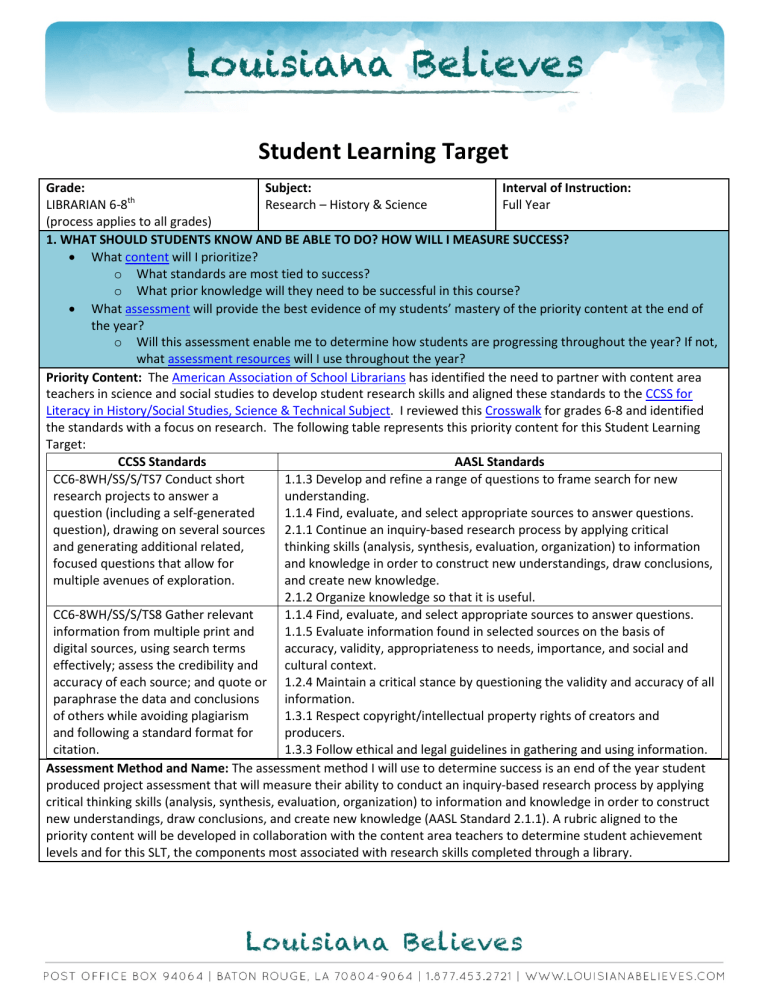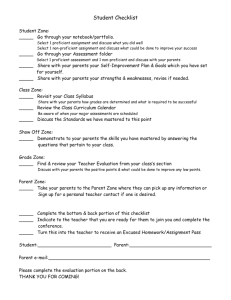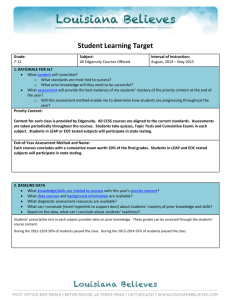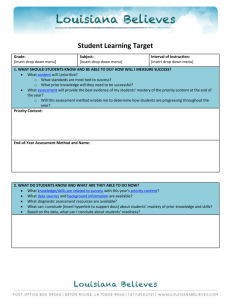Librarian-Research Student Learning Target

Student Learning Target
Grade:
LIBRARIAN 6-8 th
(process applies to all grades)
Subject:
Research – History & Science
Interval of Instruction:
Full Year
1. WHAT SHOULD STUDENTS KNOW AND BE ABLE TO DO? HOW WILL I MEASURE SUCCESS?
• What content will I prioritize? o
What standards are most tied to success? o
What prior knowledge will they need to be successful in this course?
• What assessment will provide the best evidence of my students’ mastery of the priority content at the end of the year? o
Will this assessment enable me to determine how students are progressing throughout the year? If not, what assessment resources will I use throughout the year?
Priority Content: The American Association of School Librarians has identified the need to partner with content area teachers in science and social studies to develop student research skills and aligned these standards to the CCSS for
Literacy in History/Social Studies, Science & Technical Subject . I reviewed this Crosswalk for grades 6-8 and identified the standards with a focus on research. The following table represents this priority content for this Student Learning
Target:
CCSS Standards
CC6-8WH/SS/S/TS7 Conduct short research projects to answer a question (including a self-generated question), drawing on several sources and generating additional related, focused questions that allow for multiple avenues of exploration.
CC6-8WH/SS/S/TS8 Gather relevant information from multiple print and digital sources, using search terms effectively; assess the credibility and accuracy of each source; and quote or paraphrase the data and conclusions of others while avoiding plagiarism and following a standard format for citation.
AASL Standards
1.1.3 Develop and refine a range of questions to frame search for new understanding.
1.1.4 Find, evaluate, and select appropriate sources to answer questions.
2.1.1 Continue an inquiry-based research process by applying critical thinking skills (analysis, synthesis, evaluation, organization) to information and knowledge in order to construct new understandings, draw conclusions, and create new knowledge.
2.1.2 Organize knowledge so that it is useful.
1.1.4 Find, evaluate, and select appropriate sources to answer questions.
1.1.5 Evaluate information found in selected sources on the basis of accuracy, validity, appropriateness to needs, importance, and social and cultural context.
1.2.4 Maintain a critical stance by questioning the validity and accuracy of all information.
1.3.1 Respect copyright/intellectual property rights of creators and producers.
1.3.3 Follow ethical and legal guidelines in gathering and using information.
Assessment Method and Name: The assessment method I will use to determine success is an end of the year student produced project assessment that will measure their ability to conduct an inquiry-based research process by applying critical thinking skills (analysis, synthesis, evaluation, organization) to information and knowledge in order to construct new understandings, draw conclusions, and create new knowledge (AASL Standard 2.1.1). A rubric aligned to the priority content will be developed in collaboration with the content area teachers to determine student achievement levels and for this SLT, the components most associated with research skills completed through a library.
2. WHAT DO STUDENTS KNOW AND WHAT ARE THEY ABLE TO DO NOW?
• What knowledge/skills are related to success with this year’s priority content ?
• What data sources and background information are available?
• What diagnostic assessment resources are available?
• What can I conclude about students’ mastery of prior knowledge and skills?
• Based on the data, what can I conclude about students’ readiness?
I analyzed the prior year standardized assessment data for all 637 students in grades 6-8 to identify all students who:
1) Were Non-Proficient in ELA OR 2) Dropped in achievement level in ELA
There are 159 students who were non-proficient and 63 students who dropped in achievement level from the previous year. Student count is non-duplicated. If they scored non-proficient AND dropped in achievement level, they are included in the non-proficient category.
The content teachers then administered a short research project pre-assessment (one social studies and one science related) that required the identified 222 students to engage in the inquiry-based research process using skills highlighted as priority content. We scored these using a rubric aligned to the priority content developed in collaboration with the content area teachers to measuring proficiency.
Rubric Component
Develop Research Questions
Find and Evaluate Sources
Integrate Quality Evidence
Credit/Site Sources
% of students Proficient
62%
37%
30%
58%
3. ON WHICH STUDENTS WILL I FOCUS THIS LEARNING TARGET?
• Have I set learning targets for all of my students?
• Which subgroups in my school population need additional support to achieve success?
• Which students will need additional support to achieve success in the course?
Total Population: 222 students identified above
Identified Research Skills: The majority of students lack proficiency in Find and Evaluate Sources and Integrate Quality
Evidence.
STUDENT LEARNING TARGET:
• What level of performance on the target assessment do I expect my targeted student population to achieve within the identified interval of instruction?
3. ON WHICH STUDENTS WILL I FOCUS THIS LEARNING TARGET?
• Have I set learning targets for all of my students?
• Which subgroups in my school population need additional support to achieve success?
• Which students will need additional support to achieve success in the course?
75% of students will be proficient in all four of the identified areas on the end of year research project.
SCORING PLAN:
• How will you measure your students’ success?
• Based on students’ baseline data, what is the minimum level of performance I expect from the identified students?
• Based on students’ baseline data, how many students can reasonably be expected to meet or exceed the expected level of performance?
Insufficient Attainment of Target
(1 point):
The teacher has demonstrated an insufficient impact on student learning by falling far short of the target.
Achievement range: <60% are proficient in all four areas.
Partial Attainment of Target
(2 points):
The teacher has demonstrated some impact on student learning, but did not meet the target.
Achievement range : 60% -74% are proficient in all four areas.
Full Attainment of Target
(3 points):
The teacher has demonstrated a considerable impact on student learning by meeting the target.
Achievement range: 75- 85% are proficient in all four areas.
Exceptional Attainment of Target
(4 points):
The teacher has demonstrated an outstanding impact on student learning by surpassing the target by a meaningful margin.
Achievement range: >85% are proficient in all four areas.
4. HOW WILL I MONITOR PROGRESS?
• When will I monitor students’ developing mastery of the priority content?
• What curricular resources and assessment methods will I use to determine students’ mastery of the priority content on an on-going basis?
o
Are these assessment methods aligned with the end-of-year assessment identified in Step 1?
Ongoing
I have collaborated with the social studies and science teachers to identify a minimum of 5 research tasks using guidance found in the Implementing the Common Core: The Role of the School Librarian (pgs. 17-18). These tasks will be identified for each course and include opportunities for students to demonstrate current proficiency of the identified skills. Students will receive instruction and ongoing support while completing these tasks. I will collaborate with the core area teachers to score these tasks using the identified rubric. Based on the scores at each checkpoint, I will provide targeted support to groups of students who need specific instruction around the various components.
Checkpoint 1
October: Research Tasks 1 & 2
Checkpoint 2
January: Research Tasks 3 & 4
Checkpoint 3
March: Research Task 5


